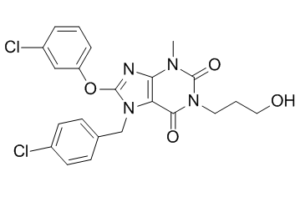HC-070
This product is for research use only, not for human use. We do not sell to patients.

For small sizes, please check our retail website as below: www.invivochem.com
| Size | Price | Stock |
|---|---|---|
| 50mg | $1100 | Check With Us |
| 100mg | $1650 | Check With Us |
| 200mg | $2475 | Check With Us |
Cat #: V22085 CAS #: 1628291-95-1 Purity ≥ 98%
Description: HC-070 is a novel and potent inhibitor of TRPC4 and TRPC5 with IC50s of 9.3 nM and 46 nM for hTRPC5 and hTRPC4 in cell assay.
Top Publications Citing Invivochem Products
Publications Citing InvivoChem Products
Product Promise

- Physicochemical and Storage Information
- Protocol
- Related Biological Data
- Stock Solution Preparation
- Quality Control Documentation
| Molecular Weight (MW) | 475.33 |
|---|---|
| Molecular Formula | C22H20Cl2N4O4 |
| CAS No. | 1628291-95-1 |
| SMILES Code | O=C(N1CCCO)N(C)C2=C(N(CC3=CC=C(Cl)C=C3)C(OC4=CC=CC(Cl)=C4)=N2)C1=O |
| Synonyms | HC-070; HC070; HC 070 |
| Protocol | In Vitro | HC-070 is an antagonist of TRPC4/TRPC5, with IC50s of 9.3 nM and 46 nM for hTRPC5 and hTRPC4, respectively. HC-070 weakly inhibits TRPC3 (IC50, 1 μM), and is at least 400-fold selective for human TRPC4 and TRPC5-containing channels versus the other channels examined. HC-070 inhibits lanthanum-activated hTRPC5-, mTRPC5-, rTRPC5-mediated currents with IC50s of 0.52 nM, 0.55 nM, and 0.32 nM in whole-cell manual patch clamp. Furthermore, HC-070 blocks M2R-activated human TRPC1/TRPC4 channels with an IC50 of 1.3 nM and La3+- and M1R-activated human TRPC1/5 channels with IC50s of 1.4 nM and 4.4 nM. HC-070 inhibits human TRPC5 currents activated via muscarinic type 1 (M1R) with an IC50 of 2.0 nM. HC-070 also suppresses hTRPC4 currents via M2R with an IC50 of 0.49 nM. HC-070 (20 nM) reduces CCK-4 evoked neuronal activity in the amygdala slices |
|---|---|---|
| In Vivo | HC-070 (1 mg/kg, p.o.) affects mice with increased evoked anxiety (CCK-4), but shows no effects in the absence of CCK-4. HC-070 (0.3, 1 or 3 mg/kg, p.o.) decreases anxiety in a standard EPM (more light/high anxiety). HC-070 (1 mg/kg) reduces the increased capacity for fear memory in mice subjected to chronic social stress on days 1-15. In addition, HC-070 (1, 3, 10 mg/kg, p.o.) causes reduction in marble burying behavior. HC-070 (0.3, 1, 3, 10 mg/kg, p.o.) also reduces time of immobility in a tail suspension test but does not impact locomotor activity in mice |
These protocols are for reference only. InvivoChem does not
independently validate these methods.
| Solvent volume to be added | Mass (the weight of a compound) | |||
|---|---|---|---|---|
| Mother liquor concentration | 1mg | 5mg | 10mg | 20mg |
| 1mM | 2.1038 mL | 10.5190 mL | 21.0380 mL | 42.0760 mL |
| 5mM | 0.4208 mL | 2.1038 mL | 4.2076 mL | 8.4152 mL |
| 10mM | 0.2104 mL | 1.0519 mL | 2.1038 mL | 4.2076 mL |
| 20mM | 0.1052 mL | 0.5260 mL | 1.0519 mL | 2.1038 mL |
The molarity calculator equation
Mass(g) = Concentration(mol/L) × Volume(L) × Molecular Weight(g/mol)
Mass
=
Concentration
×
Volume
×
Molecular Weight*
The dilution calculator equation
Concentration(start)
×
Volume(start)
=
Concentration(final)
×
Volume(final)
This equation is commonly abbreviated as: C1 V1 = C2 V2
Concentration(start)
C1
×
Volume(start)
V1
=
Concentration(final)
C2
×
Volume(final)
V2
Step One: Enter information below
Dosage mg/kg
Average weight of animals g
Dosing volume per animal µL
Number of animals
Step Two: Enter the in vivo formulation
%DMSO
+
%
+
%Tween 80
+
%ddH2O
Calculation Results:
Working concentration:
mg/ml;
Method for preparing DMSO master liquid:
mg
drug pre-dissolved in
µL
DMSO(Master liquid concentration
mg/mL)
,Please contact us first if the concentration exceeds the DMSO solubility of the batch of drug.
Method for preparing in vivo formulation:
Take
µL
DMSO master liquid, next add
µL
PEG300, mix and clarify, next add
µL
Tween 80,mix and clarify, next add
µL
ddH2O,mix and clarify.
Note:
- (1) Please be sure that the solution is clear before the addition of next solvent. Dissolution methods like vortex, ultrasound or warming and heat may be used to aid dissolving.
- (2) Be sure to add the solvent(s) in order.




































